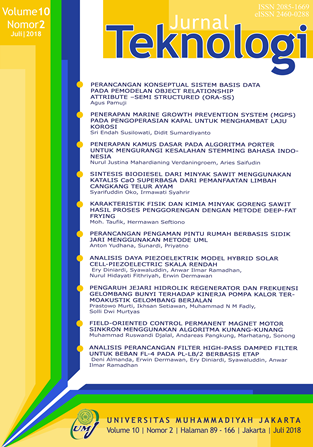PENERAPAN MARINE GROWTH PREVENTION SYSTEM (MGPS) PADA PENGOPERASIAN KAPAL UNTUK MENGHAMBAT LAJU KOROSI
Main Article Content
Abstract
Downloads
Article Details
COPYRIGHT POLICY
The author(s) of an article published in the Jurnal Teknologi retains ownership of the intellectual property rights in work (s).
PUBLISHING RIGHTS
The author(s) of an article published in the Jurnal Teknologi have unrestricted publication rights. The authors give the Jurnal Teknologi the right to publish the article and designate the Faculty of Engineering Universitas Muhammadiyah Jakarta Publishing as the original publisher of the article.
LICENSING POLICY
Journal of Mechanical Engineering and Sciences is an open-access journal that follows the Creative Commons Non-Commercial 4.0 International License (CC BY-NC 4.0), which states that:

Under this license, the reusers must give appropriate credit, provide a link to the license, and indicate if changes were made. Users may do so in any reasonable manner, but not in any way that suggests the licensor endorses users or their use.
Please take the time to read the whole license agreement (https://creativecommons.org/licenses/by-nc/4.0/). As long as reusers follow the license conditions, the owner cannot withdraw these freedoms. The following components are included under this license:
 Attribution: Users must provide appropriate attribution, including a link to the license, and indicate whether or not they made any modifications. Users are free to do so reasonably, but not in a manner that indicates the licensee approves of their usage.
Attribution: Users must provide appropriate attribution, including a link to the license, and indicate whether or not they made any modifications. Users are free to do so reasonably, but not in a manner that indicates the licensee approves of their usage.
 NonCommercial: Users may not use the material for commercial purposes.
NonCommercial: Users may not use the material for commercial purposes.
References
Atmadja, S. T. (2010). Pengendalian Korosi Pada Sistem Pendingin Menggunakan Penambahan Zat Inhibitor. ROTASI, 12 (2), 7-13
Bayuseno, A. P. (2009). Analisa Laju Korosi Pada Baja Untuk Material Kapal Dengan Dan Tanpa Perlindungan Cat. ROTASI, 11(3), 32-37.
Cheremisinoff, N. P., & Cheremisinoff, P. N. (1981). Cooling Towers Selection, Design and Practice. Michigan: Ann Arbor Science.
Delimunthe, I. S. (2004). Kimia Dari Inhibitor Korosi. Kimia Dari Inhibitor Korosi.
Deviyani.,Larisa dan Isdiriayani N. (2006). Inhibisi Korosi Baja Dalam Air Laut Mengandung Sulfida Menggunakan Glutaraldehida. Jurnal Teknik Kimia, 5 (1) 341-349. Bandung: ITB..
Diniardi, E., Ramadhan, A. I., & Basri, H. (2014). Analisis Kekuatan Mekanik Dan Struktur Mikro Pada Material Polimer Penyusun Kipas Radiator. Jurnal Teknologi, 6(1), 55-67.
Fontana, G. Mars & Norbert. D. Greene. (1988). Corrosion Engineering 2nd , International Student Edition. Jurong: McGraw-Hill Int. Book. Co.
Geiger, Gary & Mel. J. Esmacher, P.E.(2012). Controlling Corrosion in Cooling Water Systems-Part2: Inhibiting and Monitoring Corrosion. New York: American Institute of Chemical Engineers.
Grandison, C., Piola, R., & Fletcher, L. (2011). A review of marine growth protection system (MGPS) options for the Royal Australian Navy (No. DSTO-TR-2631). DEFENSE SCIENCE AND TECHNOLOGY ORGANIZATION VICTORIA (AUSTRALIA) MARITIME PLATFORMS DIV.
Herro, H. M., & Port, R. D. (1993). The Nalco guide to cooling water system failure analysis. McGraw-Hill.
Heusler, K. E., & Fischer, L. (1976). Kinetics of pit initiation at passive iron. Materials and Corrosion, 27(8), 551-556..
Karim, A. A., & Yusuf, Z. A. (2012). Analisa Pengaruh Penambahan Inhibitor Kalsium Karbonat dan Tapioka Terhadap Tingkat Laju Korosi Pada Pelat Baja Tangki Ballast Air Laut. Jurnal Riset dan Teknologi Kelautan, 10(2), 206
Kim, S. J., & Lee, S. J. (2011). Investigation on electrochemical and cavitation characteristics of rudder materials for ship in sea water. Corrosion Science and Technology, 10(3), 101-107.
NALCO., 1987, Standard Manual Procedure for Corrosion Coupon Rate, Illinois, Nalco. Co.
Nur Aziz O., 2012, Studi Pengaruh Laju Alir Fluida Terhadap Laju Korosi Baja Api SL X-52 Menggunakan Metode Polarisasi Pada Lingkungan NaCl 3,5% Yang Mengandung Gas CO2. Universitas Indonesia .
Olmsted, John and Williams G. (2007). Handbook of Chemistry and Physics, 5th edition, New York: CRC Press-Taylor & Francis Group.
Rozenfeld, I. L., 1988, Corrosion Inhibitors, New York: McGraw-Hill Co, Inc.
Sasono, E. J. (2010). Efektivitas Penggunaan Anoda Korban Paduan Aluminium pada Pelat Baja Kapal AISI 2512 terhadap Laju Korosi di dalam Media Air Laut (Doctoral dissertation, Tesis pada Prodi Magister Teknik Mesin FT Universitas Diponegoro, Semarang).
Seung-Jun, L. E. E., & Seong-Jong, K. I. M. (2011). Effects of flow velocity on electrochemical behavior of seachest 5083-H116Al alloy for ship. Transactions of Nonferrous Metals Society of China, 21(8), 1703-1709.
Soares, C. G., Garbatov, Y., Zayed, A., & Wang, G. (2009). Influence of environmental factors on corrosion of ship structures in marine atmosphere. Corrosion Science, 51(9), 2014-2026.
Revie, R. W. (2008). Corrosion and corrosion control: an introduction to corrosion science and engineering. John Wiley & Sons.
Yari, Mehdi., 2015, An Intro to Pipeline Corrosion in Seawater, Ontario: University Of Western Ontario.

